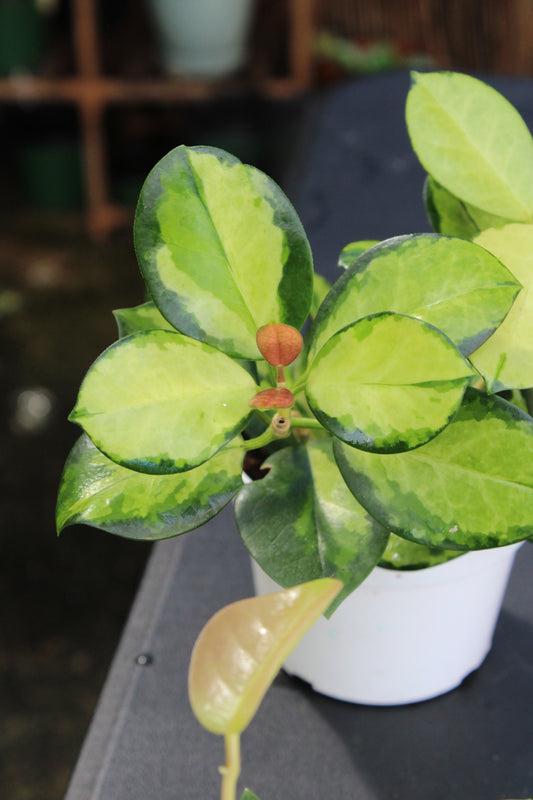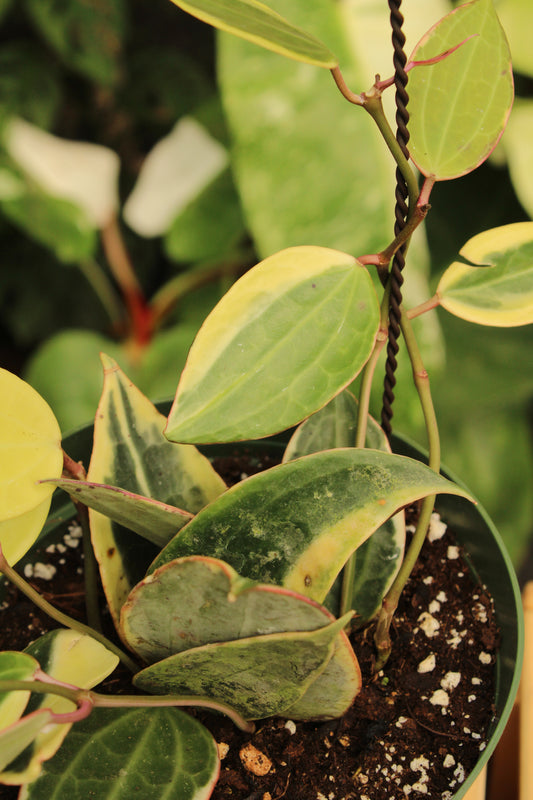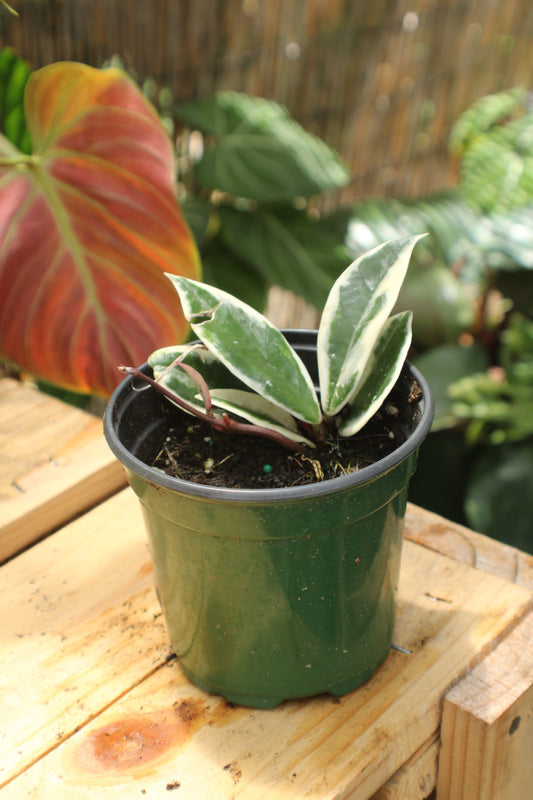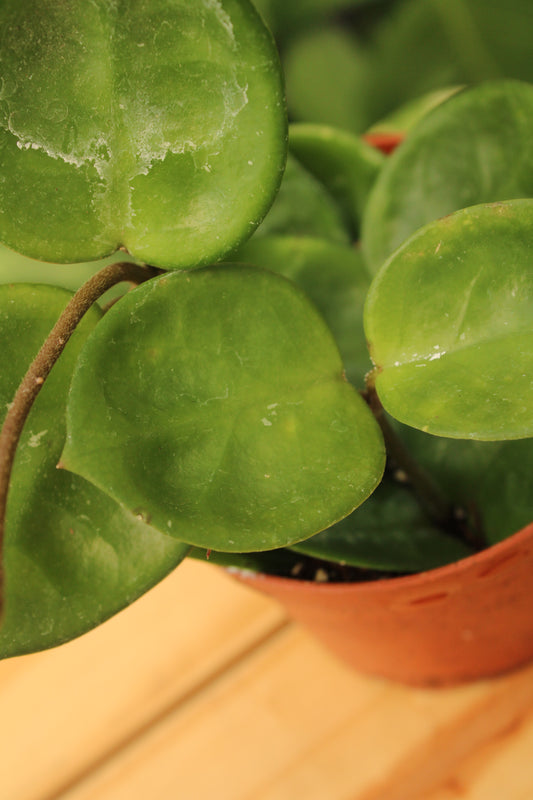
Hoya Care
Hoya plants, commonly referred to as "Wax Plants" or "Hoyas," are beloved for their waxy, often fragrant flowers and succulent-like foliage. Hoyas have gained popularity among plant enthusiasts due to their unique growth habits, diverse foliage, and captivating blooms.
Collapsible content

Australis Lisa Hoya
LIGHT
The Hoya Australis 'Lisa' prefers bright, indirect light. It can tolerate some direct sunlight, especially in the morning; but prolonged exposure to strong, direct sunlight can scorch the leaves. Low light will reduce variegation.
WATER
Water it when the top 1-2 inches of soil are dry. This plant is somewhat drought-tolerant and prefers to dry out between waterings. Overwatering can lead to root rot.
HUMIDITY
It does well in average household humidity levels but appreciates higher humidity. Aim for 40-60% humidity.
TEMPERATURE
This plant prefers temperatures between 60-85°F
FOOD
Fertilize the Hoya australis 'Lisa' every month during the spring and summer.
TOXICITY
Hoya australis 'Lisa' is non-toxic to humans and pets
Additional Tips*
This plant will benefit from a trellis since its a creeping vine.
Use a well-draining substrate, such as a mixture of coconut fiber, perlite, pine bark, and activated charcoal. This ensures good aeration and prevents excess humidity.
Use orchid bloom fertilizer to enhance the hoya blooms and make them longer-lasting.
Black Margin Hoya
LIGHT
The Black Margin Hoya likes bright indirect light, it tolerates lower light conditions. The more indirect light, the more it will bloom. Direct sunlight will burn the foliage
WATER
This hoya needs water when it's completely dry. Overwatering will cause leaf drop and it may die.
HUMIDITY
Your hoya does well in house humidity. It will benefit an additional misting.
TEMPERATURE
Your hoya does well in temperatures between 50-75 degrees.
FOOD
The Black Margin Hoya likes to be fed monthly or every other month with some general indoor plant fertilizer.
TOXICITY
It's non-toxic to pets and humans.
Additional Tips*
This plant will benefit from a trellis since its a creeping vine.
Use a well-draining substrate, such as a mixture of coconut fiber, perlite, pine bark, and activated charcoal. This ensures good aeration and prevents excess humidity.
Use orchid bloom fertilizer to enhance the hoya blooms and make them longer-lasting.
This hoya changes color if it’s sun stressed, if you are looking for that look, consider giving it more light.
Chelsea Hoya
LIGHT
The Chelsea Hoya likes bright indirect light, it tolerates lower light conditions. The more indirect light, the more it will bloom. Direct sunlight will burn the foliage
WATER
This hoya needs water when it's completely dry. Overwatering will cause leaf drop and it may die.
HUMIDITY
Your hoya does well in house humidity. It will benefit an additional misting.
TEMPERATURE
Your hoya does well in temperatures between 50-75 degrees.
FOOD
The Chelsea Hoya likes to be fed monthly or every other month with some general indoor plant fertilizer.
TOXICITY
It's non-toxic to pets and humans.
Additional Tips*
This plant will benefit from a trellis since its a creeping vine.
Use a well-draining substrate, such as a mixture of coconut fiber, perlite, pine bark, and activated charcoal. This ensures good aeration and prevents excess humidity.
Use orchid bloom fertilizer to enhance the hoya blooms and make them longer-lasting.
This hoya changes color if it’s sun stressed, if you are looking for that look, consider giving it more light.
Crassiopetiolata Hoya
LIGHT
Hoya Crassipetiolata prefers bright, indirect light. Can tolerate some direct sunlight, especially in the morning; but prolonged exposure to strong, direct sunlight can burn the leaves.
WATER
Water it when the top 2.5-5 inches of soil is dry. This plant is somewhat drought tolerant and prefers to dry out between waterings. Overwatering can cause root rot.
HUMIDITY
It does well in average household humidity levels, but appreciates higher humidity. Make sure the humidity is 40-60%.
TEMPERATURE
This plant prefers temperatures between 15 and 29 °C.
FOOD
Fertilize Hoya Crassipetiolata every month during spring and summer.
TOXICITY
Hoya Crassipetiolata is not toxic to humans or pets.
Additional Tips*
This plant will benefit from a trellis since its a creeping vine.
Use a well-draining substrate, such as a mixture of coconut fiber, perlite, pine bark, and activated charcoal. This ensures good aeration and prevents excess humidity.
Use orchid bloom fertilizer to enhance the hoya blooms and make them longer-lasting.
Kerri Hoya
LIGHT
Hoya Kerri prefers bright, indirect light. Can tolerate some direct sunlight, especially in the morning; but prolonged exposure to strong, direct sunlight can burn the leaves.
WATER
Water it when the top 2.5-5 inches of soil is dry. This plant is somewhat drought tolerant and prefers to dry out between waterings. Overwatering can cause root rot.
HUMIDITY
It does well in average household humidity levels, but appreciates higher humidity. Make sure the humidity is 40-60%.
TEMPERATURE
This plant prefers temperatures between 15 and 29 °C.
FOOD
Fertilize Hoya Crassipetiolata every month during spring and summer.
TOXICITY
Hoya Kerri is not toxic to humans or pets.
Additional Tips*
This plant will benefit from a trellis since its a creeping vine.
Use a well-draining substrate, such as a mixture of coconut fiber, perlite, pine bark, and activated charcoal. This ensures good aeration and prevents excess humidity.
Use orchid bloom fertilizer to enhance the hoya blooms and make them longer-lasting.
Krimson Queen Hoya
LIGHT
Place the Krimson Queen Hoya in medium to bright indirect light. The more light it has the more it will bloom. Do not place it in direct sunlight, it will burn the leaves. Low light will reduce variegation.
WATER
Hoyas need water when they are fully dry out. Let it dry between waterings. Overwatering will cause it to lose leaves and later, die.
HUMIDITY
This hoya does fine in house humidity. It will benefit from the occasional misting.
TEMPERATURE
Your hoya does well in temperatures between 60-85 degrees.
FOOD
The Krimson Queen Hoya likes to be fed monthly or every other month with some general indoor plant fertilizer.
TOXICITY
It's non-toxic to pets and humans.
Additional Tips*
This plant will benefit from a trellis since its a creeping vine.
Use a well-draining substrate, such as a mixture of coconut fiber, perlite, pine bark, and activated charcoal. This ensures good aeration and prevents excess humidity.
Use orchid bloom fertilizer to enhance the hoya blooms and make them longer-lasting.
Macrophylla Albomarginata Hoya
LIGHT
The Macrophylla Albomarginata Hoya likes bright indirect light, it tolerates lower light conditions. The more indirect light, the more it will bloom. Direct sunlight will burn the foliage. Low light will reduce variegation.
WATER
This hoya needs water when it's completely dry. Overwatering will cause leaf drop and it may die.
HUMIDITY
Your hoya does well in house humidity. It will benefit an additional misting.
TEMPERATURE
Your hoya does well in temperatures between 50-75 degrees.
FOOD
The Macrophylla Albomarginata Hoya likes to be fed monthly or every other month with some general indoor plant fertilizer.
TOXICITY
It's non-toxic to pets and humans.
Additional Tips*
This plant will benefit from a trellis since its a creeping vine.
Use a well-draining substrate, such as a mixture of coconut fiber, perlite, pine bark, and activated charcoal. This ensures good aeration and prevents excess humidity.
Use orchid bloom fertilizer to enhance the hoya blooms and make them longer-lasting.
Publicalix Hoya
LIGHT
The Publicalix Hoya likes bright indirect light, it tolerates lower light conditions. The more indirect light, the more it will bloom. Direct sunlight will burn the foliage
WATER
This hoya needs water when it's completely dry. Overwatering will cause leaf drop and it may die.
HUMIDITY
Your hoya does well in house humidity. It will benefit an additional misting.
TEMPERATURE
Your hoya does well in temperatures between 50-75 degrees.
FOOD
The Publicalix Hoya likes to be fed monthly or every other month with some general indoor plant fertilizer.
TOXICITY
It's non-toxic to pets and humans.
Additional Tips*
This plant will benefit from a trellis since its a creeping vine.
Use a well-draining substrate, such as a mixture of coconut fiber, perlite, pine bark, and activated charcoal. This ensures good aeration and prevents excess humidity.
Use orchid bloom fertilizer to enhance the hoya blooms and make them longer-lasting.
Rubra Hoya
LIGHT
Place the Rubra Hoya in medium to bright indirect light. The more light it has the more it will bloom. Do not place it in direct sunlight, it will burn the leaves. Low light will reduce variegation.
WATER
Hoyas need water when they are fully dry out. Let it dry between waterings. Overwatering will cause it to lose leaves and later, die.
HUMIDITY
This hoya does fine in house humidity. It will benefit from the occasional misting.
TEMPERATURE
Your hoya does well in temperatures between 60-85 degrees.
FOOD
The Rubra Hoya likes to be fed monthly or every other month with some general indoor plant fertilizer.
TOXICITY
It's non-toxic to pets and humans.
Additional Tips*
This plant will benefit from a trellis since its a creeping vine.
Use a well-draining substrate, such as a mixture of coconut fiber, perlite, pine bark, and activated charcoal. This ensures good aeration and prevents excess humidity.
Use orchid bloom fertilizer to enhance the hoya blooms and make them longer-lasting.
Sunrise Hoya
LIGHT
The Sunrise Hoya likes bright indirect light, it tolerates lower light conditions. The more indirect light, the more it will bloom. Direct sunlight will burn the foliage
WATER
This hoya needs water when it's completely dry. Overwatering will cause leaf drop and it may die.
HUMIDITY
Your hoya does well in house humidity. It will benefit an additional misting.
TEMPERATURE
Your hoya does well in temperatures between 50-75 degrees.
FOOD
The Sunrise Hoya likes to be fed monthly or every other month with some general indoor plant fertilizer.
TOXICITY
It's non-toxic to pets and humans.
Additional Tips*
This plant will benefit from a trellis since its a creeping vine.
Use a well-draining substrate, such as a mixture of coconut fiber, perlite, pine bark, and activated charcoal. This ensures good aeration and prevents excess humidity.
Use orchid bloom fertilizer to enhance the hoya blooms and make them longer-lasting.
This hoya changes color if it’s sun stressed, if you are looking for that look, consider giving it more light.
Tsangii Hoya
LIGHT
The Tsangii Hoya likes bright indirect light, it tolerates lower light conditions. The more indirect light, the more it will bloom. Direct sunlight will burn the foliage
WATER
This hoya needs water when it's completely dry. Overwatering will cause leaf drop and it may die.
HUMIDITY
Your hoya does well in house humidity. It will benefit an additional misting.
TEMPERATURE
Your hoya does well in temperatures between 50-75 degrees.
FOOD
The Tsangii Hoya likes to be fed monthly or every other month with some general indoor plant fertilizer.
TOXICITY
It's non-toxic to pets and humans.
Additional Tips*
This plant will benefit from a trellis since its a creeping vine.
Use a well-draining substrate, such as a mixture of coconut fiber, perlite, pine bark, and activated charcoal. This ensures good aeration and prevents excess humidity.
Use orchid bloom fertilizer to enhance the hoya blooms and make them longer-lasting.












